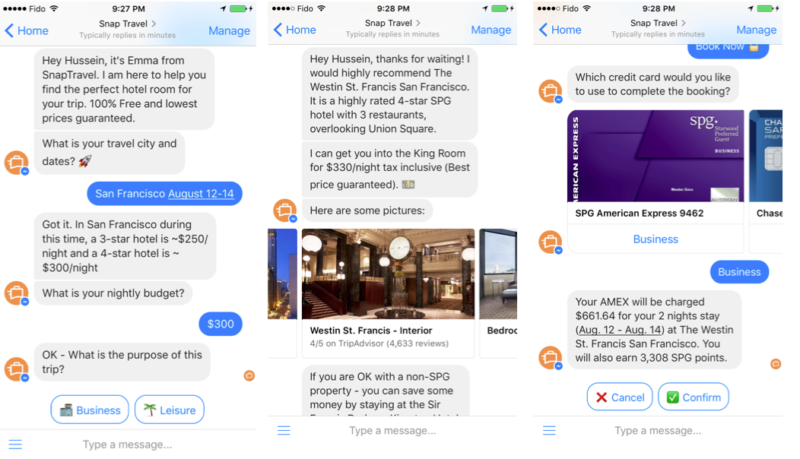4 Ways To Transform The Customer Experience With Artificial Intelligence In Mobile Apps
Artificial Intelligence may conjure up images of robots stealing all our jobs, but AI isn’t futuristic. It’s the present.
AI is as old as technology itself – the original AI systems operated more as search engines, where you inputted information and organised data comes back. But if wasn’t necessarily relevant information. Today, that’s all changed.
AI is an umbrella term, encompassing subfields such as:
- Robotics
- Machine learning
- Expert systems
- General intelligence
- Natural language processing
It essentially is data-driven, but requires human expertise to apply answers and discoveries to solve problems with it.
The AI effect:
AI technology has become widely used as elements of larger systems, but the field is rarely credited for these successes. Think of the latest advances in medical diagnosis, aviation, stock trading or robot control, and you’re likely thinking of an innovation using AI at its core.
This is described as ‘The AI effect’.
“A lot of cutting edge AI has filtered into general applications, often without being called AI because once something becomes useful enough and common enough it’s not labeled AI anymore. Many thousands of AI applications are deeply embedded in the infrastructure of every industry.” – Nick Bostrom, Superintelligence professor at Oxford University
You may not realise how powerful (and relatively simple and cost-effective) adding AI to your mobile apps can be.
Why add AI to your mobile app?
Applying AI technology to your mobile app personalises and streamlines the user’s experience at a level in-achievable by a ‘one size fits all’ interface.
- 70% of apps are abandoned by users within 7 days of downloading
- Consumer expectations currently exceed the average app’s performance in terms of bugs, loading speed and overall user experience.
- 74% of Australians rely as much on their phones as they do on their desktops when searching for information, ideas and advice.
What these stats all reveal is that the number 1 driver of app user adoption is to provide a solution that is undeniably useful and relevant to the user.
This usually means that it’s smart. By ‘smart’, I mean they require machine learning algorithms.
By simple logic, making the experience relevant to a larger group of people gives your application the chance to appeal to a wider user base.
See also: Going Viral: How To Engineer Your App’s Viral Loop
Typical problems to which AI methods are applied:
- Optical Character Recognition or Facial Recognition – Think Facebook’s automatic tagging suggestions when you upload a photo.
- Artificial creativity – For example, a ‘choose your own adventure’ style application.
- Speech recognition – Adobe’s new ‘photoshop for audio’ platform, VoCo, lets you edit speech as easily as text.
- Email spam filtering – Online grocer Ocado uses AI to prioritise customer service enquiries over busy periods, such as Christmas or during freak weather events. The technology reduces email overload on the customer service team by assessing the urgency and nature of each query using natural language processing and cloud computing.
- Information overload – Media publications that show you content based on what you’ve previously engaged with. Every time you click, the algorithm grows smarter and delivers you more and more relevant content.
The above examples illustrate how AI can solve problems as a standalone technology.
However, where AI really excels is when it’s embedded into applications to enhance the user experience, often in subtle ways the customer won’t even notice.
When would you use it?
From a business perspective, a company wouldn’t ‘buy’ an off the shelf AI solution. They would more likely leverage one of the subfields of AI in their existing platforms, to find patterns in user data and use it to make profitable app updates.
These 5 examples show us how any business with a mobile presence can create powerful, timely and relevant app experiences with AI.
1. Automated Reasoning – Uber
AI algorithms basically work the same as a decision tree – A visual representation of how the human mind quickly weighs up risk, benefit and resource cost to make decisions.
Of course, we know humans don’t make the best decisions. AI machines now beat humans at chess, stock trading and even Jeopardy.
Automated reasoning is one of the most powerful applications of AI to help the consumer complete their goal more easily.
The goal of Uber, for example, is to get the rider to their destination faster.
The Uber Driver app takes the address inputted and automatically provides drivers with the best route given the time of day and known traffic congestion.
It does this using an algorithm that takes millions of bits of data from other Uber Drivers who have traveled similar routes, and learns from their trips.
Surge pricing works through a similar algorithm to create the most efficient market and maximise the number of rides it can provide. Admittedly, this algorithm is held very close to Uber’s chest so it’s difficult to assess whether this algorithm is an honest one or whether it pads Uber’s profits.
The more data you feed an AI system, the better it gets at making decisions.
See also: How Uber Uses Data To Drive Profitable App Updates
The Takeaway:
Utility apps where users complete tasks can quite easily incorporate AI to make goal completion faster or reduce cognitive load on the user.
Examine which onerous tasks within your app could be streamlined by applying AI technology.
2. Purchase Predictions – Amazon
Online retailers make a lot of money from accurately predicting your purchase behaviours.
Amazon is currently working on rolling out anticipatory shipping, a technology that sends you items before you need them, removing the need for you to make last-minute visits to the website.
With enough data on your purchase history for certain products, Amazon can prompt you to purchase more toothpaste, for example, when its algorithm predicts you are about to run out.
Anticipatory shipping is simply the latest vehicle applying predictive analytics algorithms, which have been around for as long as the Internet itself.
These analytics can be used in many ways to increase revenue and provide a more seamless customer experience:
- Offering discounts
- Targeting advertisements
- Stocking warehouses that are close to your home with products you are likely to buy
- Informing future product and pricing decisions
Takeaway:
If your application offers in-app purchases or any kind of commerce functionality, AI is almost a necessity for increasing revenue.
3. Recommendation Services – Netflix
This is perhaps the simplest and most effective application of AI in mobile apps, and can be applied to almost any solution.
The reason why most apps fail within a year of launch is that they fail to provide fresh content to continuously engage app users.
The trouble is, you may be pumping out fresh content regularly, but if it isn’t relevant to the end user than it isn’t worth the time you spend crafting it!
By monitoring the choices users make and inserting them into a learning algorithm, these apps make recommendations that you’re likely to be interested in.
We’ve seen this be a powerful source of revenue for entertainment apps like Netflix or iView, yet any business that upsells or cross-sells content can utilise this AI.
For example, a health club app which gives users access to class timetables could ‘remember’ which classes you typically search for and create a ‘favourites’ tab tailored to you.
This reduces the amount of steps returning app users need to complete to access the information they typically search for.
Once enough session data has been captured, the app could use your search history to recommend new classes tailored to you.
Someone who only ever searches for yoga and pilates may be interested in meditation and body balance classes, but is unlikely to be interested in recommendations for karate classes.
The takeaway:
Does your business upsell or cross-sell any products or content? Even if it’s currently a manual process handled by the sales team, this could be digitised in your app offering.
4. Learned behaviour patterns – SnapTravel Bot
Most platforms have the capability to learn users’ behaviour patterns in order to make the next session more seamless.
Snaptravel is a newcomer to the travel booking industry, and is essentially a half-bot, half-human hotel booking service.
What sets SnapTravel apart from Expedia and Booking.com’s own bots is their unique approach to using its chatbot and human agents to assist travelers in finding and booking their accommodations.
SnapTravel uses natural language processing and machine learning to have realistic conversations with users suited to their preferences.
If a user stumps the bot with a request, a human agent intervenes and teaches the bot how to not make the same mistake next time.
“Each hotel booking trains the machine learning model as it works towards full automation,” said Henry Shi, SnapTravel CTO and cofounder.
See also: Are ChatBots A Fad? What Needs To Change For Consumers To Embrace Them
Another classic example of AI learning your behaviour is fraud detection for your credit card.
Pattern-detecting algorithms go through your credit card statements and purchases as they happen, and can detect if you’ve made a recent purchase out of the norm of your behaviour.
Uber is also rolling out this AI application in an update over November 2016. If it knows you always take an Uber home from work at 5pm, instead of you having to request one it will prompt you with a shortcut to your home address at 4.55pm.
The takeaway:
Customers are becoming increasingly demanding for technology that works WITH them, not for them.
According to Apptentive, 70% of apps are abandoned after the first week. This means that the first 1-5 app sessions are crucial for retaining new customers.
You’re much more likely to make these sessions memorable if you use AI technology to learn their behaviour and make each app session more valuable than the last.
Data is a privilege, and you owe it to your customers to use it to improve the experience for them.
As these applications show, AI is an exciting space to be in. Forward-thinking businesses are rapidly integrating AI into their mobile apps to create hyper-useful ‘mobile moments’ for their customers.
How could your application benefit from AI technology?
Latest posts by Logan Merrick (see all)
- Ep 18: Collective Campus’ CEO on Intrapreneurship and Corporate Innovation - December 20, 2016
- 50 User Engagement Strategies For Planning Memorable Mobile Experiences - December 19, 2016
- Latest Data: App Monetisation Trends And Drivers 2015-2020 - November 25, 2016







